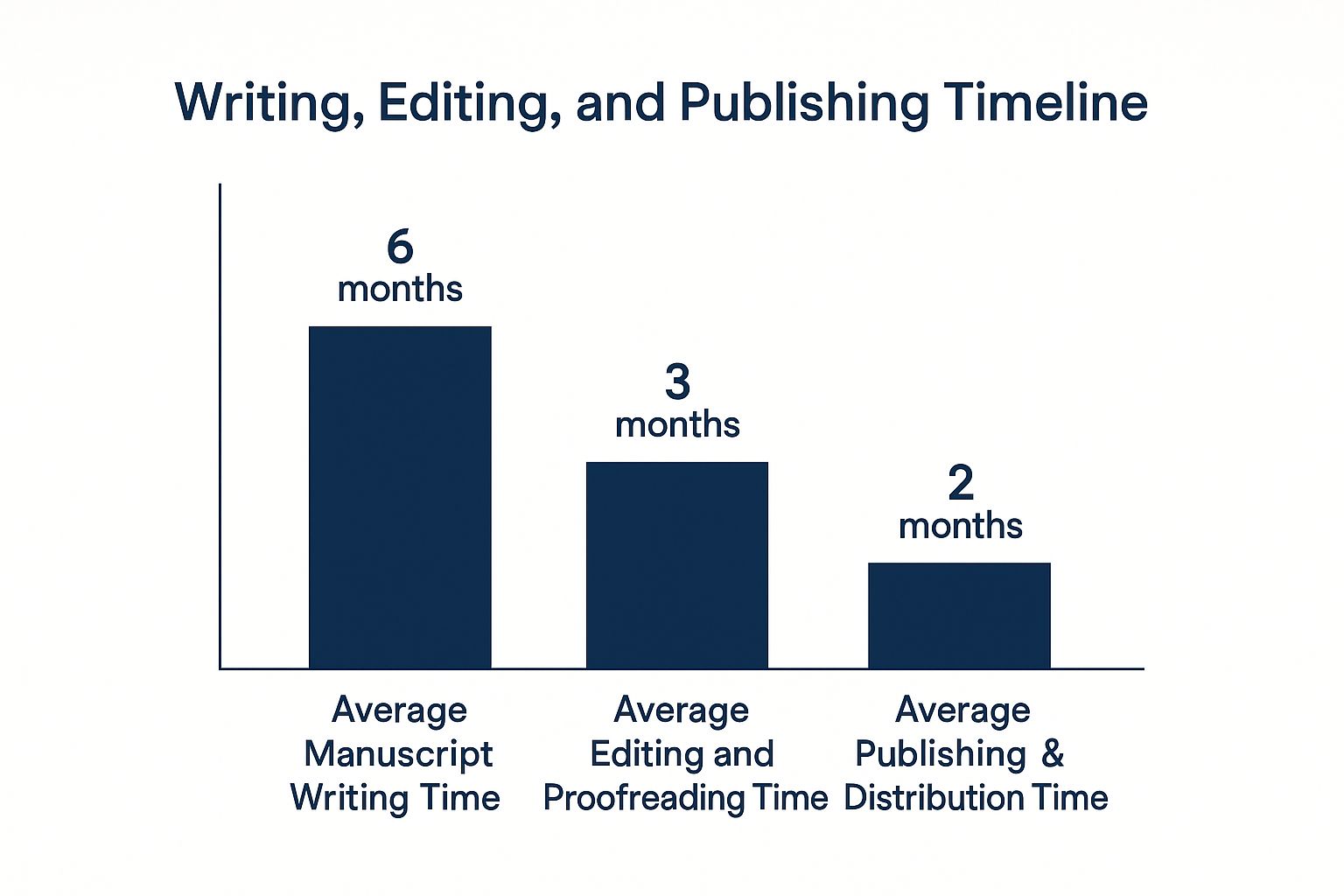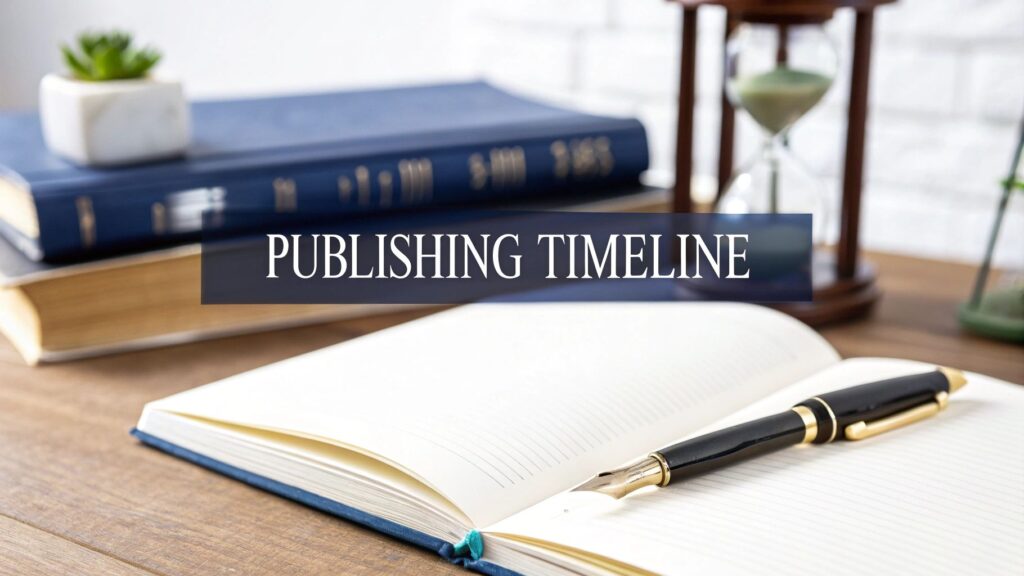Traditional Vs Self-Publishing: The Real Time Difference
Choosing between traditional publishing and self-publishing is a big decision for authors. A key factor is often the timeline. How long does it take to publish a book? The answer depends heavily on your chosen path. Traditional publishing is a lengthy process, often taking 18 months to several years from finished manuscript to bookstore shelves. Self-publishing, however, allows authors to manage the entire process, often publishing in a matter of weeks or months.
Understanding the Traditional Publishing Timeline
Traditional publishing involves many steps, each adding significant time. The process begins with finding a literary agent, which can take 6-12 months of querying and revisions. Securing an agent is just the first hurdle.
After finding an agent, submitting your manuscript to publishers can take another 3-6 months. A publisher may request further revisions before offering a contract. Even after acceptance, the editing, production, and distribution stages can easily add another year to the process. You might be interested in: How to become a published author.
The Self-Publishing Express Lane
Self-publishing offers a much faster route. Authors control every step, enabling a quicker turnaround. A motivated author can often publish within 4-8 weeks. Some authors choose to invest 6-12 months for a more polished final product.
This variance in timeline depends on factors such as the book's complexity and the author's dedication to tasks like editing and cover design. The infographic below visualizes the average time allocated for key steps in self-publishing: writing, editing/proofreading, and publishing/distribution.

As the infographic shows, even with dedicated time for each stage, self-publishing is significantly faster than traditional publishing. However, speed doesn't diminish the importance of careful planning and execution.
To further illustrate the key differences in timelines between these two publishing paths, let’s take a look at the following comparison:
Traditional vs Self-Publishing Timeline Comparison
A detailed breakdown comparing timeframes for each major step in traditional versus self-publishing processes
| Publishing Phase | Traditional Publishing | Self-Publishing | Key Factors |
|---|---|---|---|
| Finding an Agent | 6-12 months | Not Applicable | Agent research, querying, revisions |
| Submitting to Publishers | 3-6 months | Not Applicable | Publisher research, submissions, revisions |
| Editing | 3-6 months | 1-4 months | Editorial feedback, revisions |
| Production/Formatting | 6-12 months | 2-4 weeks | Typesetting, cover design, formatting |
| Distribution | 2-3 months | 1-2 weeks | Printing, shipping, online distribution |
| Total Time | 18 months – Several Years | 4 weeks – 12 months | Author involvement, book complexity |
This table clearly highlights the significant time difference between traditional and self-publishing. While traditional publishing can stretch for years, self-publishing allows authors to bring their books to market much faster. The key factors influencing the self-publishing timeline are the author’s level of involvement and the complexity of the book itself.
The publishing world has changed. The process of publishing a book varies greatly depending on the chosen route. Traditionally published books require multiple steps, adding substantial time. Self-publishing offers a faster, more flexible approach. Self-publishing has seen significant growth, with a 264% increase in the past five years. Learn more about self-publishing statistics. This surge reflects its growing popularity among authors who value speed and control.
Breaking Down The Traditional Publishing Marathon

Traditional publishing often evokes a sense of romanticism, but the reality is a lengthy and intricate process. For authors considering this path, it's important to understand the time commitment involved. From completing your manuscript to finally holding your published book, the journey can span from 18 months to several years.
The Querying Gauntlet
The first significant challenge is securing a literary agent. This typically involves sending numerous query letters to agents, who each receive hundreds of submissions. The querying process itself can take 6-12 months, often filled with rejections and manuscript revisions. This means a significant portion of your publishing timeline is already consumed even before a publisher seriously considers your work.
Submission and Acquisition: A Waiting Game
Once you have an agent, they will begin submitting your manuscript to publishers. This stage can add another 3-6 months to the process. Publishers often have extensive acquisition procedures, involving multiple rounds of internal review. While this waiting period can be challenging, it's a crucial step in traditional publishing.
Editing and Production: Refining Your Work
After a publisher accepts your manuscript, the detailed work begins. The editing process usually involves multiple rounds of revisions with your editor, which can take 3-6 months. Once the manuscript is finalized, it moves into the production phase. This includes typesetting, cover design, and formatting, adding another 6-12 months to your timeline.
Distribution: Reaching Your Readers
Finally, your book is prepared for distribution. This phase involves printing physical copies and coordinating their shipment to bookstores, a process that can take 2-3 months. Unforeseen circumstances, such as printing delays or logistical issues, can further extend this final stage. This final step brings your book to the market, marking the completion of the traditional publishing marathon, a journey demanding substantial time and effort.
Strategies for Potential Acceleration
While traditional publishing inherently involves a lengthy timeline, strategic approaches can potentially expedite certain stages. Developing a strong author platform and networking with industry professionals can be beneficial in attracting agents and publishers. A well-polished manuscript, free of significant errors, can also streamline the editing process. However, it's important to maintain a balance between speed and quality, as rushing through crucial stages can compromise the potential of your book. Understanding the traditional publishing timeline allows authors to set realistic expectations. Although the process is a marathon, for many authors, the reward of seeing their book in bookstores makes the journey worthwhile.
The Self-Publishing Fast Track: What You Control

Self-publishing offers authors significant control over their book's journey, including the timeline. This means you decide how long it takes to publish a book. Some authors manage to publish within 4-8 weeks, while others take a more measured approach of 6-12 months. What factors contribute to this variation in timelines?
Essential Steps You Can't Skip
Certain steps are non-negotiable for producing a professional, high-quality self-published book. These are essential for a polished final product and shouldn't be skipped, regardless of your desired timeline.
-
Professional Editing: Editing ensures your manuscript is error-free and reads smoothly. It's a vital step for refining your work and presenting it in the best possible light.
-
Cover Design: Your book cover is the first impression for potential readers. A professionally designed cover attracts attention and effectively communicates the book's genre and tone.
-
Formatting: Proper formatting is crucial for a positive reading experience across various e-readers and print formats. It ensures your book is accessible and enjoyable for all readers.
These essential steps typically require several weeks to complete, depending on the book's length and complexity.
Streamlining Without Sacrificing Quality
While some steps are essential, others can be streamlined to expedite the publishing process without compromising quality.
-
Marketing: While a robust marketing strategy is important, extensive campaigns can be implemented after the book launch. Initially, focus on generating pre-orders and securing early reviews.
-
Advanced Review Copies (ARCs): ARCs are valuable for early feedback, but their distribution can be timed closer to the publication date to save time.
This strategic approach allows authors to prioritize essential tasks and maintain professional standards while managing their timeline effectively.
Learning From Self-Published Authors
Gaining insights from other self-published authors' experiences, including their timelines and challenges, can be invaluable. Many successful authors share their journeys, offering practical advice on navigating potential bottlenecks and maximizing efficiency.
Some authors, for instance, discover the cover design process takes longer than anticipated, requiring several revisions to achieve the desired result. Others encounter formatting delays, particularly when preparing both ebook and print versions.
Learning from these experiences allows you to anticipate potential challenges, adjust your expectations, and develop a realistic publishing timeline. This provides a clearer understanding of how long it takes to publish a book through self-publishing and sets you up for success.
How Digital Publishing Changed Everything
The digital revolution has irrevocably transformed the publishing industry, significantly impacting how long it takes to bring a book to market. This shift offers authors unprecedented speed and global reach, empowering them to connect with readers faster than ever before.
Eliminating Traditional Bottlenecks
Traditional publishing often involved a complex and time-consuming process. Printing schedules, shipping logistics, and inventory management added months, even years, to publication timelines. Digital publishing removes these bottlenecks. E-books and audiobooks, free from the constraints of physical production and distribution, can reach a global audience instantly.
The Rise of Digital-First Strategies
This new paradigm has led to the rise of digital-first strategies. Authors, both established and emerging, recognize the benefits of rapid publication. For time-sensitive topics, a digital release allows authors to capitalize on current events and trends, an advantage impossible with traditional publishing timelines. Furthermore, digital platforms like Amazon KDP and Apple Books offer authors more control over pricing and marketing, further enhancing the appeal of digital publishing.
The growth of e-books and audiobooks signifies a shift in reader preferences. In 2022, e-book revenues saw a 12.4% increase, while audiobooks experienced a 16.5% rise. This demonstrates the expanding digital audience and the efficiency of reaching them through digital channels. This shift has reduced both the time and cost associated with traditional methods, making it easier for authors to connect with their readers. Find more detailed statistics here.
Democratizing the Publishing Process
Platforms like Amazon KDP and Apple Books have democratized the publishing process, enabling authors to bypass traditional gatekeepers. This direct access to readers significantly shortens the journey from manuscript to market. While authors now manage aspects like marketing and cover design, services like BarkerBooks provide support for these crucial elements, ensuring a polished product while retaining the speed advantage of digital publishing.
Emerging Trends in Digital Publishing
The digital evolution continues. Emerging trends such as AI-assisted editing and automated formatting further streamline the publishing process, enabling authors to refine and prepare their work more efficiently. As technology progresses, the time required to publish a book will likely continue to decrease, allowing authors to focus on their craft and engage with readers more effectively. Embracing these changes provides authors with a distinct advantage in the dynamic publishing landscape.
Common Delays And How To Avoid Them
Even the most carefully planned book publishing projects can experience delays. This section explores common setbacks that can add weeks, or even months, to your publication timeline, and provides strategies for avoiding these obstacles.
Manuscript Revisions and Cover Design Iterations
Lengthy revisions can significantly impact your schedule. For example, multiple rounds of back-and-forth communication with editors on manuscript changes can easily add several weeks to the process. Similarly, repeated iterations of the cover design can become a major bottleneck. Each revision requires time for feedback, adjustments, and further review.
To minimize these delays, establish clear expectations with your editor and designer from the outset. Set concrete deadlines and adhere to them as much as possible. Also, be prepared to compromise and make timely decisions to prevent getting stuck on minor details.
Technical Formatting and Platform Approval Processes
Technical formatting issues can cause unforeseen setbacks. Problems with file conversions or meeting platform-specific requirements can stall your publication. Similarly, platform approval processes, such as those on Amazon KDP or Apple Books, can be time-consuming and may require adjustments to your files.
Incorporating buffer time into your schedule is crucial to account for these potential technical hiccups. Testing your formatted files on various devices beforehand is highly recommended. This allows you to identify and address any problems before submitting your book for approval. Knowing how to get an ISBN is important; learn more in our article about How to get an ISBN for my book. The growth of digital publishing has been driven by the use of multiple marketing channels; learn more with these omnichannel marketing examples.
Communication and Backup Plans
Maintaining open and effective communication with your publishing team is essential. Regular check-ins can help identify potential delays early on. A simple email update, for example, can prevent misunderstandings and ensure everyone is on the same page.
Having backup plans in place is also crucial. If your primary plan encounters a problem, having alternative solutions ready can save valuable time. This could involve having a backup designer or considering different distribution platforms. Ultimately, anticipating potential delays and proactively implementing these strategies can help maintain momentum and ensure a smoother publishing process.
Planning Your Personal Publishing Timeline

Every author's publishing journey is different. Your personal publishing timeline should reflect your unique goals, available resources, and any constraints you might face. Understanding how long it takes to publish a book is a personal calculation. Let's explore creating a realistic and personalized plan.
Assessing Your Manuscript's Readiness
Honestly evaluating your manuscript's current state is the first step. Is it a finished first draft, or has it been revised multiple times? This initial assessment will significantly impact your timeline. A manuscript needing substantial revisions will naturally require more time than a polished one. For instance, heavy editing could add several months.
Also, consider essential professional services like editing and cover design. Budgeting appropriately for these, both financially and time-wise, is crucial for a high-quality final product.
Setting Achievable Milestones
Setting realistic milestones maintains motivation and prevents feeling overwhelmed. Break the publishing process into smaller, manageable steps. This could involve completing a chapter weekly or hiring a professional editor within a month. When planning, remember some processes are inherently time-sensitive. For example, selling a house quickly requires strategic planning (learn more about a faster house selling process). This analogy highlights the value of efficient planning in any complex project.
Furthermore, consider your personal schedule. Work and family commitments will affect your available time for publishing tasks. Be honest about your availability and develop a timeline that fits your current commitments. For a helpful overview, check out our guide on How to become a published author.
Building a Flexible Timeline
Your timeline should be adaptable. Circumstances change, and your plan should adjust accordingly. Include buffer time for unexpected delays. This allows adjustments without jeopardizing overall progress. This flexibility helps maintain momentum, even amid unexpected challenges. You stay on track, even when life throws a curveball.
Using Planning Tools
Practical tools, like the worksheet below, can be incredibly beneficial. These tools offer a structured way to organize tasks, allocate time, and track your progress. The following table provides a framework to estimate the duration of each task and understand their interdependencies, helping you develop a realistic, customized timeline for publishing your book.
Publishing Timeline Planning Worksheet
| Task | Time Required | Dependencies | Tips for Acceleration |
|---|---|---|---|
| Manuscript Revision | 2-6 months | Author, Editor | Set clear deadlines, focused writing sessions |
| Professional Editing | 1-4 months | Completed Manuscript | Secure editor early, provide clear guidelines |
| Cover Design | 2-4 weeks | Finalized Manuscript Title | Communicate vision clearly, provide examples |
| Formatting | 1-2 weeks | Finalized Manuscript | Use professional software like Adobe InDesign, test on various devices |
| Platform Submission/Approval | 1-2 weeks | Formatted Files | Research platform guidelines, ensure compliance |
This structured approach clarifies how long each step might take and how different tasks are interconnected. This knowledge empowers you to create a realistic and personalized publishing timeline.
Making Your Publishing Decision: Speed Vs. Other Factors
How long does it take to publish a book? We've explored traditional and self-publishing timelines, but speed is only one factor. This section helps you weigh speed against other vital elements, so you can make the best decision for your book and your writing career.
Creative Control: Shaping Your Vision
Traditional publishing often means giving up some creative control. Publishers may suggest changes to your manuscript, title, or even the cover design. While this advice can be helpful, it might not fit your original vision. Self-publishing, on the other hand, gives you complete creative freedom. You are in charge of all decisions, shaping your book precisely as you intended.
Financial Investment: Weighing the Costs
Traditional publishing usually requires less upfront investment. The publisher handles expenses like editing, cover design, and marketing. You receive a smaller percentage of royalties in this model. Self-publishing requires more initial financial outlay since you invest in those services yourself. This includes paying for editors, cover designers, and marketing. However, you keep a larger portion of the profits.
Marketing Support: Reaching Your Audience
Traditional publishers offer marketing support, promoting your book to their existing network. This often includes media outreach and bookstore placement. Self-published authors are responsible for their own marketing. This takes effort and investment to connect with readers and establish an audience.
For example, a traditionally published author might leverage the publisher's connections with book reviewers. This can result in broader media coverage. A self-published author may choose to invest in advertising or build a robust social media presence.
Long-Term Career Goals: Building Your Platform
Think about your long-term career goals. Traditional publishing offers prestige and can lead to other opportunities. These might include speaking engagements or literary awards. Self-publishing lets you build your platform directly, controlling your brand and fostering connections with readers.
This direct connection means a self-published author potentially maintains tighter control over their intellectual property. They also build a one-on-one relationship with their readers. A traditionally published author often benefits from the publisher’s network and the established reputation of traditional publishing. Consider how each path aligns with your overall ambitions as a writer.
Making the Right Choice For You
The right publishing path depends entirely on your priorities. Evaluate your resources, your objectives, and the specific needs of your book project. The best choice can even change between books or with evolving life circumstances.
Are you prepared to invest in professional services to maintain creative control and a larger share of profits? Or is the support and validation of a traditional publisher more appealing? Examining these trade-offs will enable you to make a strategic choice that supports your continued success.
Ready to begin your publishing journey? Let BarkerBooks help you bring your book to life. We offer comprehensive services for both traditional and self-published authors, ensuring a professional and rewarding outcome. Visit BarkerBooks today to learn more.
Article created using Outrank
